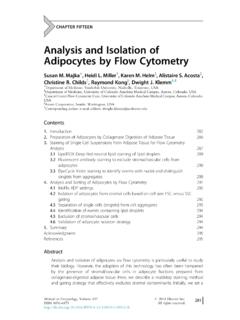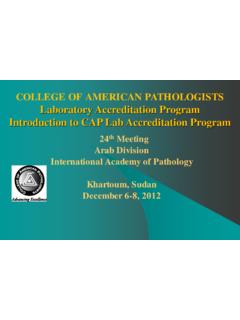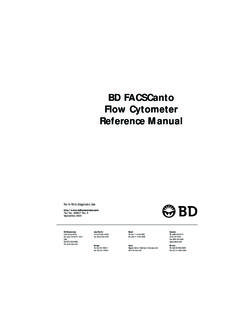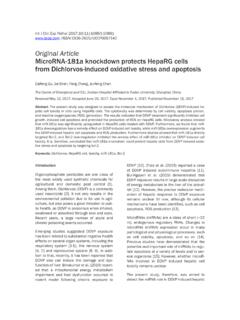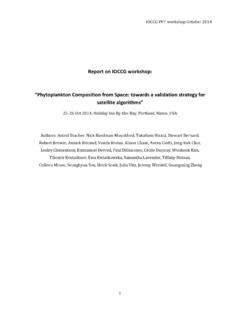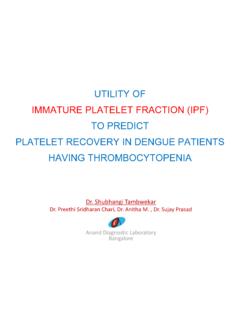Transcription of Laboratory Guidelines for enumerating CD4 T …
1 Laboratory Guidelines for enumerating CD4 T Lymphocytesin the context of HIV/AIDSL aboratory Guidelines for enumerating CD4 T Lymphocytesin the context of HIV/AIDSSEA-HLM-392 Distribution: Limited Laboratory Guidelines for enumerating CD4 T Lymphocytes in the context of HIV/AIDS Regional Office for South-East Asia New Delhi, June 2007 WHO Library Cataloguing-in-Publication Data World Health Organization, Regional Office for South-East Asia. Laboratory Guidelines for enumerating CD4 T lymphocytes in the context of HIV/AIDS 1. T lymphocytes methods 2. CD4-positive T lymphocytes immunology 3. HIV infections diagnosis 4. Quality assurance, health care 5. Laboratory techniques and procedures methods 6. Flow cytometry methods 7. Guidelines . ISBN 978-92-9022-298-9 (NLM classification: WH 200) World Health Organization 2007 This document is not issued to the general public, and all rights are reserved by the World Health Organization (WHO).
2 The document may not be reviewed, abstracted, quoted, reproduced or translated, in part or in whole, without the prior written permission of WHO. No part of this document may be stored in a retrieval system or transmitted in any form or by any means electronic, mechanical or other without the prior written permission of WHO. The mention of specific companies or of certain manufacturers products does not imply that they are endorsed or recommended by the World Health Organization in preference to others of a similar nature that are not mentioned. Errors and omissions excepted, the names of proprietary products are distinguished by initial capital letters. The views expressed in documents by named authors are solely the responsibility of those authors. Page iii Contents Page 1.
3 Natural history of HIV 1 Magnitude of 1 Biology of HIV .. 2 Pathogenesis of HIV .. 5 Factors influencing HIV disease 8 WHO clinical staging of HIV-related disease in adults and adolescents aged 15 years or 9 2. Role of CD4 T lymphocytes in disease 11 CD4 T lymphocytes and HIV .. 11 CD4 T lymphocyte counts and antiretroviral therapy .. 12 CD4 T lymphocytes counts as indicator of treatment failure .. 14 CD4 T lymphocytes counts in paediatric 16 3. Principles of flow 18 18 What is flow cytometry?.. 18 Instrument 19 Use of fluorochromes in flow cytometry: .. 22 4. Methods of CD4 T lymphocytes count 24 24 Flow cytometric methodologies .. 24 Selections of Methodology for CD4 T lymphocytes count estimation .. 32 Importance of Reference ranges in interpretation of the CD4 T lymphocytes counts obtained by in the Laboratory .
4 33 5. Alternate methods for CD4 T lymphocytes 37 37 Manual methods .. 37 Methodologies likely to become available in the near 38 Non-CD4 markers for monitoring HIV disease progression and for initiation and monitoring the success of anti-retroviral therapy .. 39 6. Quality Management in CD4 T lymphocytes 42 Management 42 Technical requirements .. 44 7. Establishing a Laboratory for CD4 T lymphocytes 48 Suggested requirements at different levels .. 48 Selection of Methodology for CD4 T lymphocytes counts .. 49 Suggested testing at different levels .. 49 Establishment of a CD4 T lymphocytes enumeration 50 Annexes 1. Collection and transport of 52 2. General bio-safety Guidelines for immunophenotyping 55 3. Pipetting 57 4. Format for sample transport, receipt and report 59 5.
5 Useful 61 6. List of 62 Page 1 Chapter 1 Natural history of HIV infection Magnitude of problem The HIV/AIDS pandemic has severely affected health development and eroded improvements in life expectancy, particularly in countries with the highest prevalence of infection. Since the first cases of acquired immunodeficiency syndrome (AIDS) were reported in 1981, infection with human immunodeficiency virus (HIV) has grown to pandemic proportions, resulting in more than 65 million infections and 25 million deaths. At the end of 2006, an estimated million people were living with HIV, with Sub-Saharan Africa carrying the highest burden. In 2006, an estimated million people became newly infected with HIV. More than 95% of these new infections are in low and middle income countries.
6 Each day 11,000 persons become newly infected with the virus; of these, half are women and 40% are young people (15-24 years old). Of the estimated 37 million adults living with HIV worldwide, nearly 18 million are women. At the end of 2006, there were an estimated million children living with HIV. The increasing number of child deaths due to AIDS threatens to reverse many of the recent gains of child survival programmes. Moreover, the socio-economic impact of HIV/AIDS on children is profound. As their parents fall sick and die of AIDS, children undergo a long trail of painful experiences such as: economic hardship, withdrawal from school; lack of love, attention and affection; psychological distress, stigma, discrimination and isolation, and malnutrition and illness. Cumulatively, there are a total of 16 million children worldwide who have become orphans because their parents died of AIDS.
7 HIV burden in South-East Asia Region The WHO South-East Asia (SEA) Region includes: Bangladesh, Bhutan, the Democratic People s Republic of Korea, India, Indonesia, Maldives, Myanmar, Nepal, Sri Lanka, Thailand, and Timor-Leste. The overall adult HIV prevalence in south and south-east Asia is , relatively much lower Laboratory Guidelines for enumerating CD4 T lymphocytes in the context of HIV/AIDS Page 2 than the prevalence in sub-Saharan Africa. However, due to the large populations, even low HIV prevalence means that large numbers of people are living with HIV. At the end of 2006, there were an estimated million people living with HIV in SEA Region. This included million new infections in 2006. Approximately 550,000 persons died of AIDS during 2006. Five countries - India, Thailand, Myanmar, Indonesia and Nepal account for a majority of the burden in this Region.
8 Long-standing epidemics have left a huge burden of people living with HIV/AIDS (PLHA) who need prevention, care and treatment services. Table provides the estimated number of PLHA in each country in the Region. Table : HIV/AIDS Burden in South-East Asian countries, December 2005 Country Adult HIV Prevalence (%) Estimated number of people Living with HIV Bangladesh < 7 500 Bhutan < < 500 DPR Korea n/a n/a Indonesia 193 000* India 5 200 000** Maldives < <100 Myanmar 339 000**
9 Nepal 70 000 Thailand 541 000 Sri Lanka < 5 000 Timor-Leste < <100 *data for 2006 ** among persons aged 15-49 years Source: Country reports, National AIDS Programmes, Ministries of Health Biology of HIV HIV is a lentivirus that belongs to the family Retroviridae and is characterized by single stranded RNA genome. It relies on enzyme reverse transcriptase for reverse transcription of RNA into DNA that gets integrated into host genome as a provirus.
10 Laboratory Guidelines for enumerating CD4 T lymphocytes in the context of HIV/AIDS Page 3 Structure of HIV HIV is an enveloped virus measuring about 120 nm in diameter. The virus core consists of two copies of positive single-stranded RNA that code for the nine genes enclosed in a conical capsid composed of 2,000 copies of the viral protein p24. The single-stranded RNA is tightly bound to nucleocapsid proteins, p7 and enzymes needed for the development of the virion such as reverse transcriptase, proteases, ribonuclease and integrase. A matrix composed of the viral protein p17 surrounds the capsid ensuring the integrity of the virion particle. This is, in turn, surrounded by the viral envelope which is composed of two phospholipid layers drawn from the host cell membrane when a newly formed virus particle buds from the cell.










